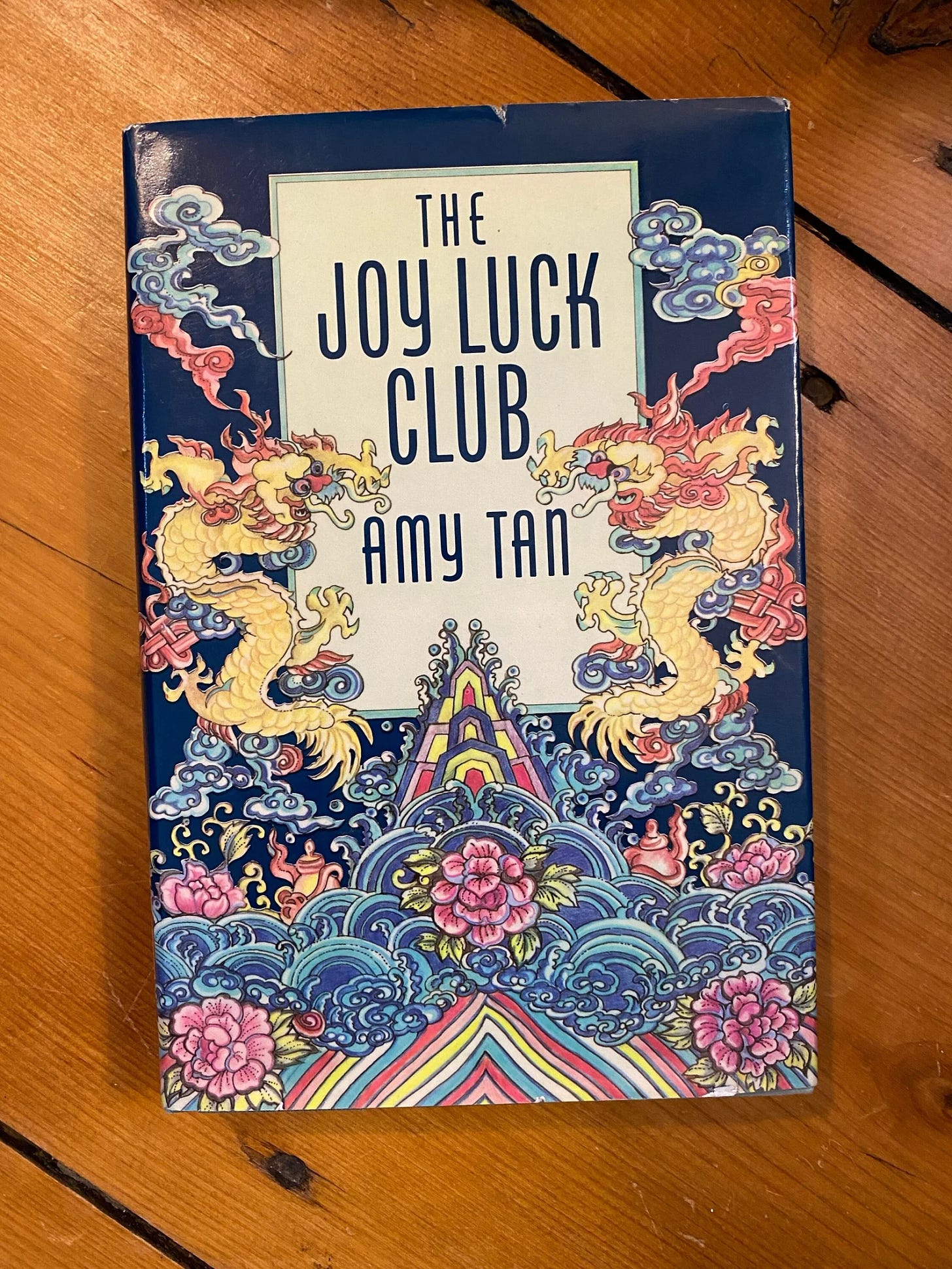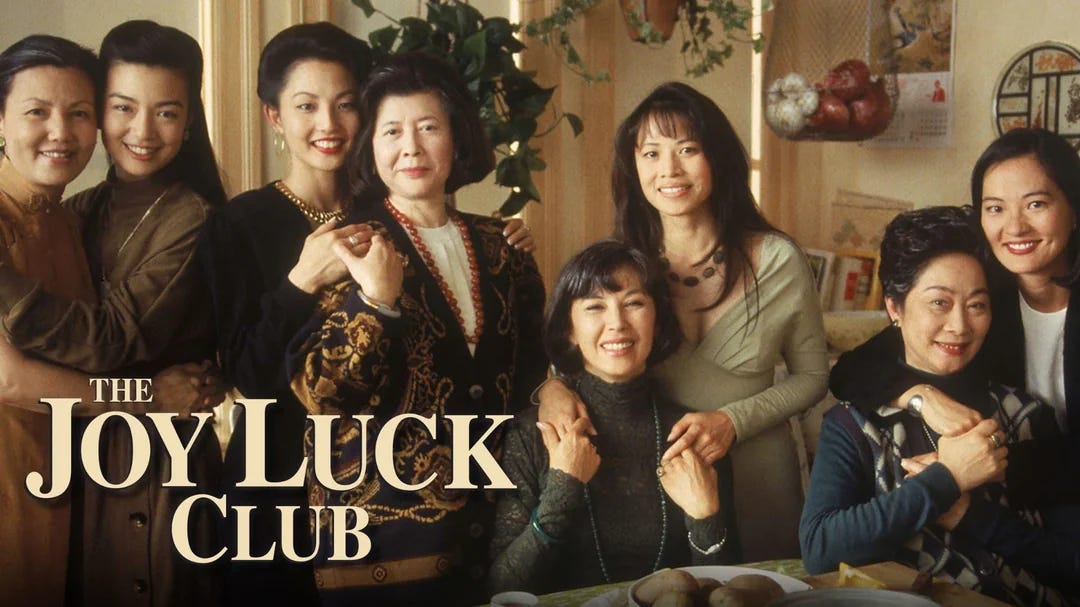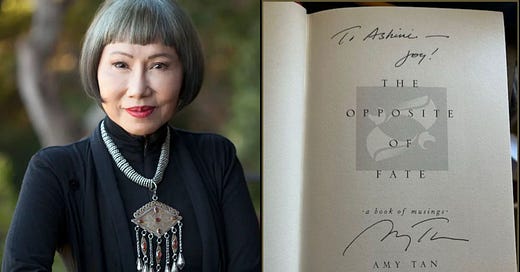In Her Words: The Joy of Amy Tan
"As an Indian-American from an immigrant family, it was exciting to see cultural references common across Asian cultures in a mainstream best seller; we were used to hiding our differences."
To celebrate Dandelion Revolution Press’s fifth anniversary, we’re running the essay series “In Her Words: Celebrating Women in Literature” throughout 2025. We’re seeking personal essays recognizing women authors and/or characters that have impacted your life. To submit your personal essay, please read our full submission guidelines.
Today, we’re thrilled to bring you . While Ashini doesn’t write for a living, she writes to live. In this essay, Ashini highlights an author who not only introduced her to the vibrant world of Asian American literature but also helped pave the way for others. Enjoy!
In the late 1980s, it was so hard to find any Asian writers. We studied Maxine Hong Kingston in women’s lit class, there was Bharati Mukherjee and VS Naipaul floating through certain circles, and Salman Rushdie was in hiding. In 1989, along came Amy Tan.
Everyone was abuzz about The Joy Luck Club. My friends and classmates were seeking out this book and devouring it. The book follows four immigrant Chinese families in San Francisco, diving into mother and daughter relationships within a multi-generational context. The basic premise was so clear, and the stories are universally relatable.

As an Indian-American from an immigrant family, it was exciting to see cultural references common across Asian cultures in a mainstream best seller; we were used to hiding our differences. We communicated love through food and laid judgement on the quality and presentations. We had aunties who had an unsolicited say in our lives, mothers who pushed us and didn’t accept mediocrity, and family friends who were like cousins and competition at the same time. Tan took it further by engaging us with fascinating historical aspects of Chinese culture. She brought us into a world of concubines and multiple wives, of women who committed suicide and babies who died tragically. And, there was the mother who had to leave the twin babies by the roadside so she wouldn’t curse them with her dead body. I’m sorry, if you want me to cry at the drop of the hat, just repeat the words “twin babies by the roadside.” And tears will well in my eyes. How did Amy Tan create this story with beautiful details that evoked so much emotion?
Finally Hollywood paid attention in 1993 and made the first movie with a full Asian cast as main characters. When the movie was released, I was eager to see this, especially since I had read the book a few times by then. Since it’s always a struggle for me to lure someone to see a “movie adapted from a book” with me, I was grateful this time to see it alone.
Reader, I cried through the movie. I had chills seeing June and her mother. The piano performance. The dinners. And, oh my God, the twin babies by the roadside had me ugly sobbing! This is why we watch movies alone.

I followed Amy Tan’s writing with The Kitchen God’s Wife, One Hundred Secret Senses, and Bonesetter’s Daughter. The stories were captivating and for some reason, I was always left craving dumplings. I later learned that Tan was a foodie and regularly ate while writing.
After Tan’s success, more Chinese and Japanese writers initially emerged, and I gravitated towards any book by any Asian writer. I could identify with the cultural undertones and immigrant experience, which I believed would be adequate. Around the mid-to-late 1990’s, there was the rise of Indian writers like Chitra Bannerjee Divakaruni, Arundhati Roy, Vikram Seth and Jhumpa Lahiri. Now, a trip to a bookstore would result in a purchase of a book by an Indian author. My shelves were overflowing!
In the early 2000’s, Amy Tan was on a book tour for her memoir, The Opposite of Fate at the Free Library of Philadelphia. It was a weeknight, so after work, I left my baby daughter with my husband and made the hour-long trip to the city in the rain. On the way home, the roads were flooded and led through detours; of course, I was low on gas and had to hunt for it. That stressful evening was worth it because I met Amy Tan during the book signing. Like a giddy fool, I just gushed about how much The Joy Luck Club meant to me as an Indian-American. She acknowledged me and we chatted a bit. I told her that the twin babies on the side of the road killed me every time. She said she hears that a lot!
Recently, I reread Opposite of Fate last year and I had forgotten how much upheaval she’s had in her real life with her own mother, the successes and the hardships. This is one of the many quotes I had flagged in the book, which resonated with me as a writer.
“If I had to give myself any sort of label, I would have to say I am an American writer. I am Chinese by racial heritage. I am Chinese-American by family and social upbringing. But I believe that what I write is American fiction by virtue of the fact that I live in this country and my emotional sensibilities, assumptions, and obsessions are largely American. My characters may be largely Chinese American, but I think Chinese-Americans are part of America.”
These days, the work from Asian American writers are ubiquitous with televised series like Pachinko, based on Min Jin Lee’s Korean historical fiction novel, or Kevin Kwan’s Crazy Rich Asians. Now when I browse bookstores, I see Asian and South Asian names across all genres, from young adult to fantasy and science fiction to romance, proving writers of Asian origin are every bit mainstream American.
While other literary historians and publishers may have different opinions about writers who break barriers, I believe Amy Tan led the way with The Joy Luck Club.
Ashini J. Desai balances creative writing with a family and a technology career, given a BA in English and MS in Information Science. While she does not write for a living, she writes to live, especially coming from a family of writers and readers. Her work is published in Dandelion Revolution Press’s anthologies, Not Quite As You Were Told, The Secrets We Keep and Every Breath Alight. Her poems have been published in anthologies Cities, Overplay/Underdone, as well as various literary journals. Her selected poems are found on AshiniPoetryBlogspot.com and on Instagram as @AshiniWrites.
Cover photo from Penguin and Ashini’s personal signed copy.







Thank you for writing this piece and sharing what the author means to you. Your essay offered insight I hadn't considered before--how much more meaningful a well written story is coming from one's own cultural identity. I'm not Asian American, but am drawn to and appreciate a few writers, such as Tan, who offer a richness behind their characters, influenced by their heritage. Recently, enjoyed books by Ruth Ozecki, Celeste Ng and Jhumpa Lahiri.
As someone who reads more than I care to admit, I will have to admit I haven't read Amy Tan's work. However, I will. I will indeed, after your remarkable review. Your words offer enlightenment and should certainly resonate with authors. I hope to come back to your words again. God bless you in all your endeavors.